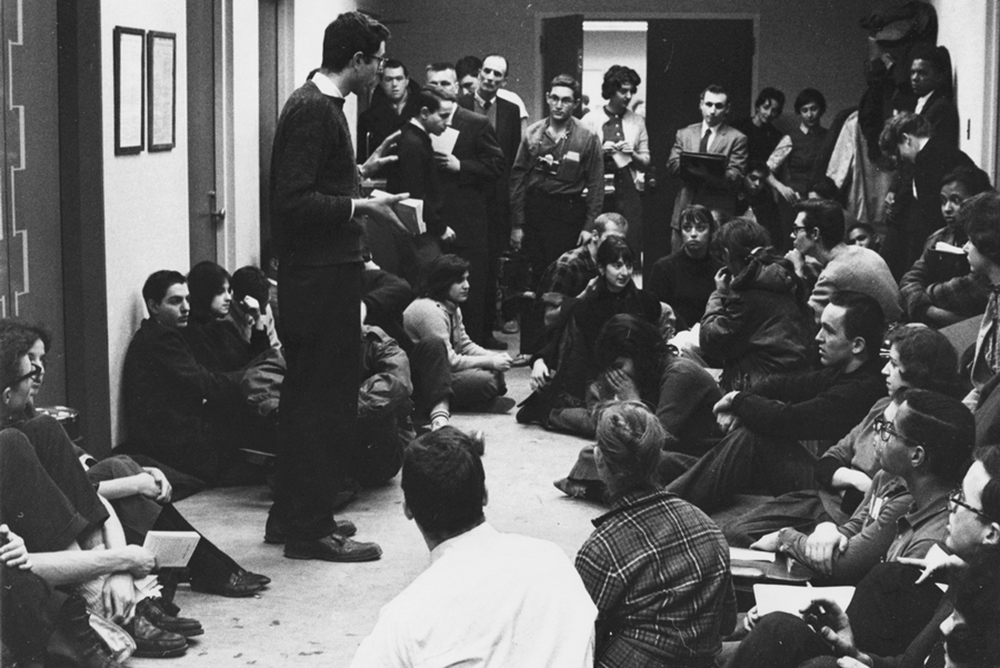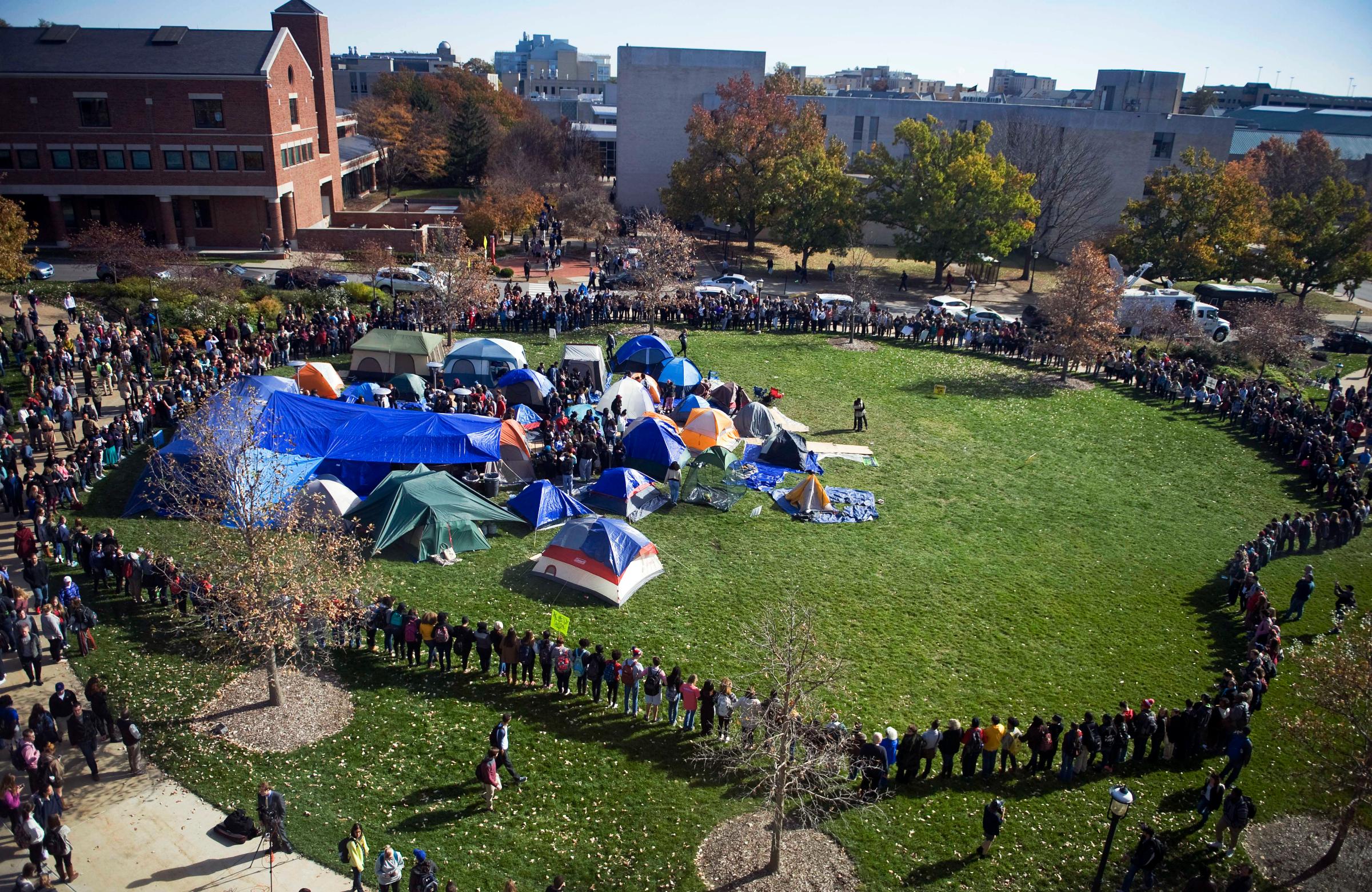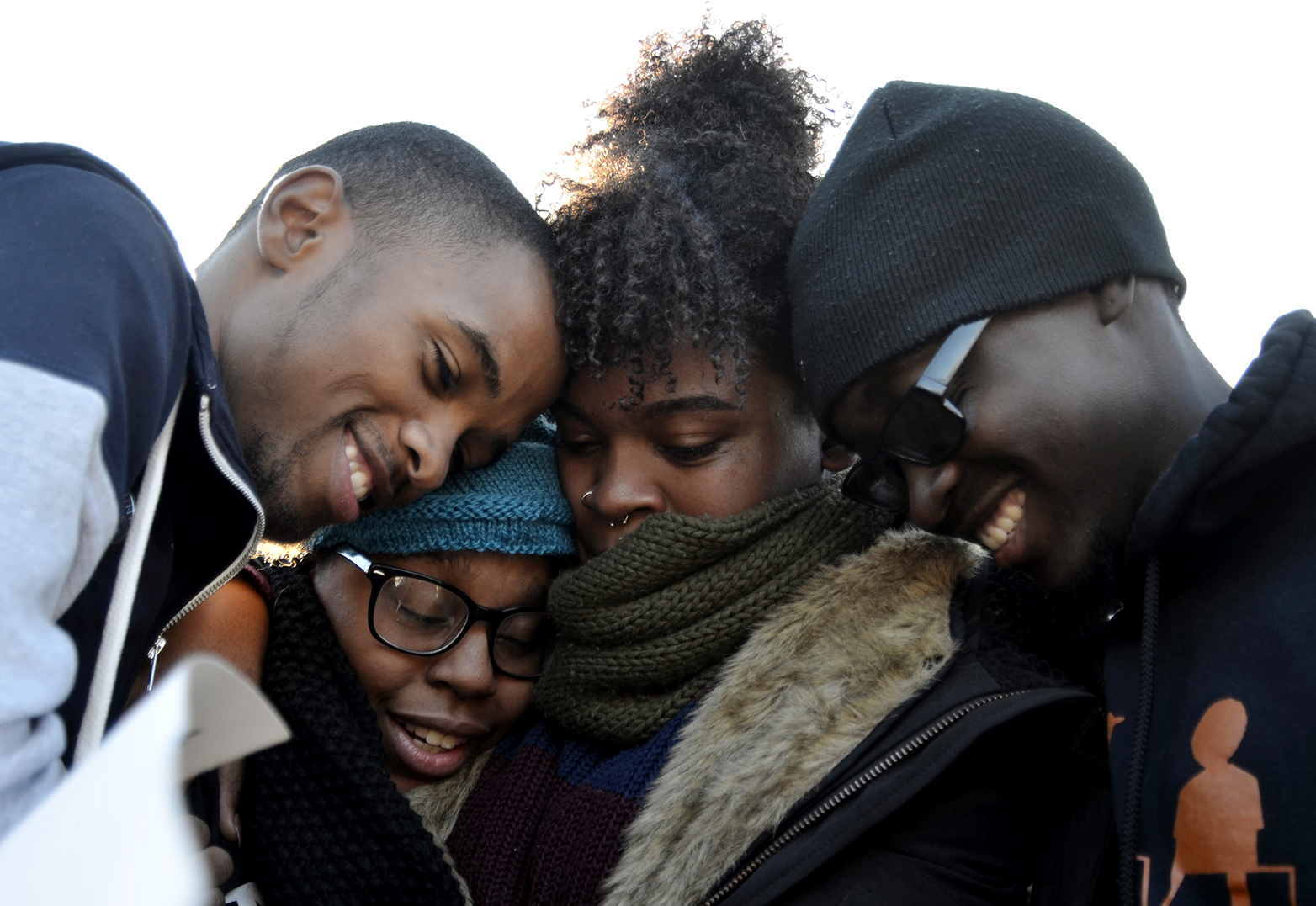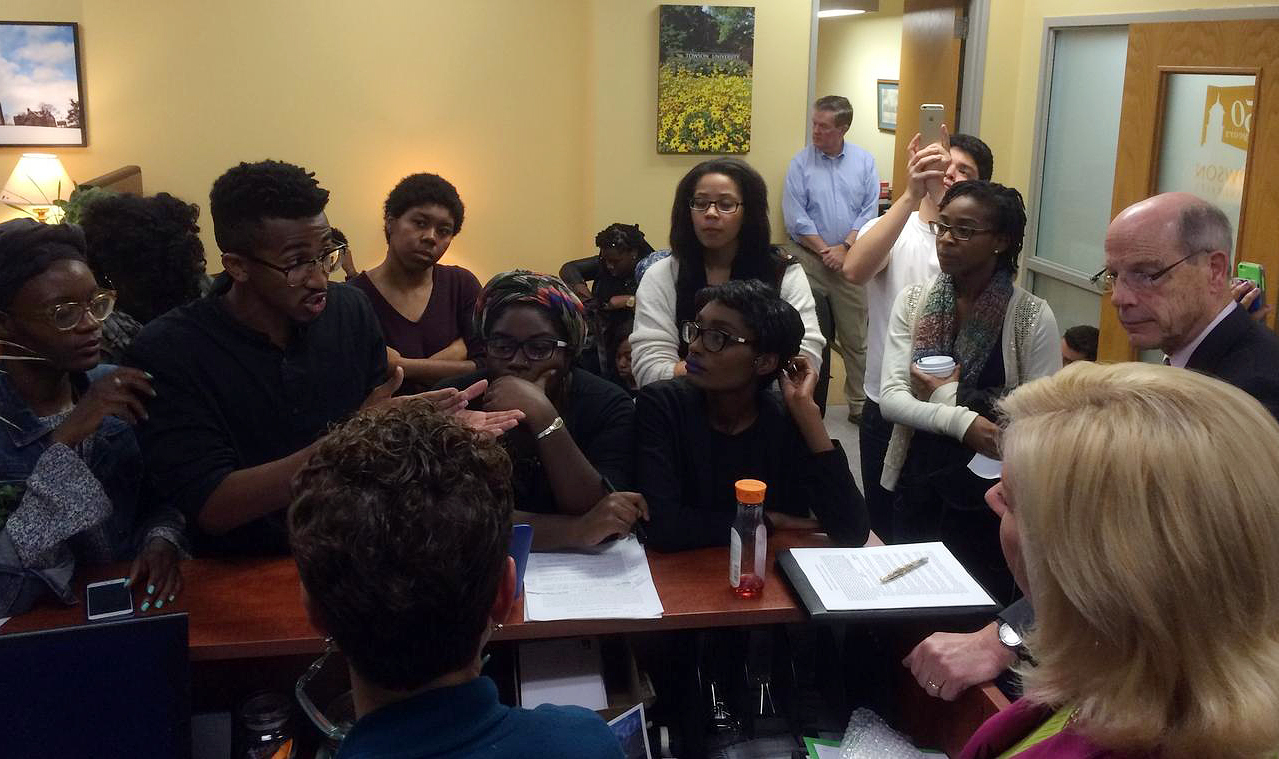
Pity the commencement speakers charged with capping this academic year. After two semesters of vigorous protest on campuses all over the nation, how can the usual chase-your-dreams exhortations suffice? At the University of Missouri, a graduate student’s hunger strike prompted the football team to announce a walkout, compelling in turn the resignations of the university president and chancellor. At Claremont McKenna College in California, protesters drove out the dean of students. Under pressure, Harvard and Yale did away with the title “master.” And at more than 50 schools in all, student protesters made demands to right what they see as historic wrongs—demands for greater faculty diversity, new courses, public apologies, administrators’ ousting. The spring semester brought no end to the upheaval; after winter break, students occupied administrative offices at Duke and Providence College as well.
It’s been a half century since we’ve seen U.S. colleges so roiled. The latest results from a long-running annual UCLA study, published in February, quantified the phenomenon: The share of students who said there was a “very good chance” they would participate in a protest while enrolled rose to 8.5 percent nationwide from 5.6 percent in 2014. (Among black students, the share climbed from 10.5 percent to a full 16 percent.) These figures were the highest the survey had recorded since it began in 1967—encompassing the eras of the military draft, the Kent State shootings, the anti-apartheid movement and the protests against the war in Iraq.

Yet for all its force, ubiquity and urgency—and for all the significance it could have in the coming years and decades—the year’s groundswell has managed only to baffle the broader public. To the cynic, each demonstration was only the latest spasm of a generation given to immature angst. Adding to the confusion, this year’s campus protest, and the movement that has supported it, has no Bob Dylan as its bard, it has no Ramparts as its house organ. And, perhaps more crucially, no Vietnam War dividing the nation. The civil rights movement thriving now, Black Lives Matter, has galvanized supporters nationwide but has focused primarily on police homicides, which is to say that it does not immediately present itself as an issue in college life.
What, then, do the protesters want?
***
Student protest in America is as old as college itself. A pamphlet prepared in 1969 for the benefit of overwhelmed administrators collects a few early examples: In 1638, Harvard students took the beatings that came after they griped about the cooking of the house master’s wife, and in 1766, the campus hosted what is considered the first American student protest—the Butter Rebellion. As the story goes, the butter served on campus was so bad that one Harvard man (Henry David Thoreau’s grandfather, to illustrate how long ago this was) cried out “Behold, our butter stinketh!—give us therefore butter that stinketh not.”
When the 20th century came around, the American university evolved and the nature of student activism with it. Colleges once fixated on providing their pupils a classical education turned themselves toward research, expansion and the attendant fundraising obligations, and students began to worry about whether their ascendant institutions vouched for the proper values. In parallel the student population at major universities diversified from the children of privilege to a heterogeneous bunch including returning GIs, more Jews, more blacks, and eventually women. The civil-rights movement of the late 1950s and early 1960s mobilized college students, both black and white, to a degree never before witnessed. But the ’60s student movement occupies an uneasy position in American history. On its fundamental planks—antiwar, antiracism, antipatriarchy—the movement scored major victories. University black, Chicano, and women’s studies departments are a direct result of the movement’s activism. So is the 26th Amendment, ratified in 1971, which lowered the voting age to 18.
Today, the echoes of the 1960s resound in so many arenas, including the presidential race. The supporters of Donald Trump have cribbed Nixon’s language from 1968, calling themselves a silent majority. And two old student radicals are running for the nomination of the Democratic party. At the University of Chicago, Bernie Sanders led a student chapter of the Congress of Racial Equality and was arrested; at Wellesley, Hillary Clinton led a two-day student strike and was offered a job after graduation with community organizer Saul Alinsky.

***
Half a century later, students across the country have called for colleges to establish safe spaces, lounges where a student can feel free of the weight of one’s race, ethnicity or gender. Another recurrent student grievance concerns microaggressions, a type of interaction in which a joke, slight, or look passively dehumanizes a member of a marginalized group. The accrual of microaggressions, it goes, constitutes racism. Elsewhere, student protesters called for new titles and building names. Harvard and Yale did away with “master”; Princeton debated whether to strip Woodrow Wilson’s name from one of its graduate schools. At California-Berkeley, students demanded that Barrows Hall, named for a former university president, be renamed for Assata Shakur, a former Black Panther and member of the Black Liberation Army.
Demands like those can make the movement seem simply another skirmish in the tedious culture war Americans have been fighting for decades. That war, to be sure, rages still on campuses in new, unexpected and confounding ways. Many have reported a rise in students requesting trigger warnings, or alerts whenever emotionally difficult material might appear on the syllabus. (An unscientific 2015 survey of professors by the National Coalition Against Censorship suggested that 15% of professors had been asked at least once to provide trigger warnings.) In a Knight Foundation survey published in April, 54 percent of students said that the climate on campus prevents some people from saying what they believe because they are fearful of offending others.
In March, at Emory University in Atlanta, dozens of students protested the president after “TRUMP 2016” was written in chalk all over campus. Some said they were made to feel unsafe. Though Trump’s positions do not especially concord with the pluralism avowed by Emory and its peers, disagreeable politics in an election year have historically called for counter-politicking rather than protest. And it is a rational response to protests like those at Emory to think that college campuses are turning more hostile to free expression rather than less.
Two of the most visible protest moments in the fall pointed to that possibility. In November, Yale found itself the unwitting star of a video that would be viewed more than 1.2 million times on YouTube. A female senior was captured on the quad shouting down the master of one of the school’s residential colleges after he had defended the primacy of academic freedom: “It is not about creating an intellectual space! It is not! Do you understand that? It’s about creating a home here!… You should not sleep at night. You are disgusting.” She walked off before the professor could respond. That same month, the University of Missouri had its own viral hit to match Yale’s, with a tally of more than 3 million views on YouTube. The video featured a student photojournalist, Tim Tai, trying to document a student protest. Students chanted at him, “Hey hey, ho ho, reporters have got to go.”

These clips capture sorry moments for the Socratic dialectic and for the doctrine of free speech on campus. And they demonstrate a regrettable coarseness. “The free-speech advocates and the student activists are talking past each other,” says Angus Johnston, a historian who studies student activism.
But the conduct captured in the videos has little to do with the movement’s aims. Social media tends to strip misdeeds of their context before spreading them far and wide. Exceptional, emotional actions can come to seem poignant and representative rather than isolated. Was the spring’s movement—the greatest swell in student activism in decades—truly the depicted farrago of screaming, shoving and casual repudiation of the First Amendment? Not exactly.

***
I visited Towson University this winter in order to see how one college was experiencing this tumult. Towson, its employees and fans will tell you, is a big school with a small-school feel. It’s a neat, suburban campus, located in the southern part of Baltimore County in Maryland. This year the college celebrated its 150th anniversary, and its present-day mission has a good deal in common with its past. It was founded as a teacher’s college, and it still educates more teachers than any other school in the state. It also churns out more healthcare graduates than any other Maryland school. The student body is 62 percent white and more than 16 percent black, more or less reflecting the demographics of Baltimore County.
The school looks in many ways like America’s average large four-year public college. But not all of the resemblance is good. Of the school’s 604 tenured or tenure-track faculty, just 28, less than five percent, are black. The numbers nationwide—six percent of all full-time faculty at four-year institutions—are hardly any better. Faculty diversity has proven harder to pull off than student-body diversity; the problem comprises not only retention struggles at universities but the struggle to diversify doctoral programs. This gap is pernicious, warping the curriculum and how students see themselves.
Animating every march, die-in and issuance of demands this year, was one provocative, unassailable claim: Black students matter. They would no longer tolerate the status quo, no matter the decades of apparent progress in higher ed and elsewhere. (Perhaps, anyway, the progress has stalled, for black students and others. Despite all the talk from elected officials about the economic value of increasingly expensive college degrees, the unemployment rate of recent graduates remains higher than pre-recession levels. College has come to seem to many hardly better than any other modern American racket.) One activist, sophomore Bria Johnson, told me that new students tend to have their worldviews reinforced rather than challenged when the cafeteria workers are almost all black and the professoriate is almost all white. Bilphena Yahwon, a graduating senior from Baltimore, says, “Being black on this campus… you know that there’s a me, and there’s a them. And you’re always hyper-conscious of everything you do. You’re constantly editing yourself. I don’t want to be too black. I don’t want to fit into that stereotype. And that’s exhausting.”

One piece of history did make the Towson protests different from others: On April 12, 2015, 25 minutes south of campus, in West Baltimore, 25-year-old Freddie Gray was arrested for allegedly possessing an illegal switchblade. A week after his arrest he was dead, the result of injuries sustained during an alleged “rough ride” in a police van. His death prompted protests and riots in Baltimore and eventual charges for the cops involved in his arrest and transport. Towson’s location did not insulate it from the upheaval down I-83. The day after the riots, Donn Worgs, the professor who directs Towson’s African and African American Studies program, was teaching his course on African-American politics. One student in his class, he said, worked at the CVS that had been burned down. By the class’s next meeting, many of his students had gone to Baltimore to help with the clean-up or to march. Student protesters rallied in Freedom Square, at the center of campus, then took a bus to Baltimore to march with black students from other area colleges.
“I like to say we extended Baltimore to campus,” says John Gillespie, a junior double major in English and philosophy who helped organize the Gray rally.
When Towson’s students returned to campus in the fall, the Gray demonstrations fresh in their minds, they watched closely the action underway at the University of Missouri. Politically active black students on campus—“we all know each other,” Johnson jokes—began to consider what they could do in solidarity. Says Yahwon, “It’s younger black people that are dying… we’re starting to see ourselves in them.” A number of black student groups held a meeting on Nov. 11 to discuss the events at Missouri and race more generally.
And so #OccupyTowson was born. On Nov. 17, the protesters, about two dozen of them, took over a Towson student government meeting bearing a list of demands. The next day, at 4 p.m., the group marched to the administration building at the southeast corner of campus. Like so many students at so many American campuses, they headed for the president’s office, on the third floor.

For eight hours on that Nov. 18 afternoon and evening, the student protesters shared their stories, their chants and their demands. Timothy Chandler, an Englishman who had become interim president in 2014, and his staff listened. The sides negotiated. Some demands the administrators had no latitude to agree to. Others were stricken, as they called for initiatives that were already underway. The students took breaks to plan and eat pizza. The administrators took breaks of their own. Any student who left the building was not allowed back in.
At 12:40 a.m., Chandler signed his name to a revised list of demands: The university would increase the number of tenure-track black faculty and work to better retain them; the president would advocate for a course requirement in race relations and efforts to improve diversity in student government, Greek life, and tenure review. Were he to fall short of his promises, he would be bound to “resign as president of this University for failing to effectively represent black students.” The enduring image of Towson’s protests would be a scene of hugs and smiles and tears, of compromise.
“As I said at the start, I admire your courage hugely, I admire your stick-to-itness. Now please don’t let this be the end of the conversation, please let this be the beginning of the conversation,” Chandler said, according to The Towerlight, Towson’s student newspaper.
If the most striking part about the Towson protest is that it resulted in a signed agreement, the second most striking fact is that the students responsible for it believe they have accomplished essentially nothing. What, after all, did the interim president’s signature mean? (Towson would appoint Kim Schatzel, the president of Eastern Michigan University, its permanent president in January, and she agreed to abide by the demands.) And with Brown University pledging more than $100 million towards a diversity initiative, and Yale putting $50 million toward its own such program, what could state-funded Towson do?
Towson has committed to addressing the demands and apprise the campus of its progress in the student paper. The school will also be hiring a vice president of inclusion and institutional equity. “This work is evolving for Towson in a productive dialogue that exists because of the work we have done in the past and the relationships we have built over many years,” says Ray Feldmann, Towson’s senior director of communications.
Recent events have only further signaled how difficult that work will be. Late in April, the Towerlight reported that a white student had harassed black workers with racial slurs at a campus cafeteria earlier that month, and that police had investigated the incident but found no evidence of a crime. Black students began tweeting about their own experiences at Towson using the hashtag #TheTowsonIKnow, citing aggressions both micro and macro. Their tweets scrolled on a screen at Freedom Square. Overnight, a chalkboard there containing anti-racist messages was defaced, the slogans replaced by the words “SATAN RULES TOWSON.”
Afterward, Schatzel announced that Towson would be reviewing and reforming the process by which students could report incidents of hate and bias. She wrote in a campuswide email, “We condemn hate speech and any racist behavior toward a member of our community, and it will not be tolerated. The university is responsible for making sure that individuals who violate our policies prohibiting discrimination are held accountable.” The student government lent its support to another anti-hate hashtag: #NotAtTU.
The student activists who had led the successful protest in November had realized long before the spring that their work was just beginning. Gillespie says, “I used to think that in order to solve the problem of being black in America you just had to teach people.” Now, he says, he recognizes that teaching isn’t enough. Black people have to organize on a grand scale, and that’s not easy.
Gillespie, though, has an idea for what he can do. “It’s about trying to get black people through the day… so they’re not having to worry about what it means to be black” in white communities, ones as small and self-contained as college classrooms and ones as big as the entire country.
More Must-Reads from TIME
- Donald Trump Is TIME's 2024 Person of the Year
- Why We Chose Trump as Person of the Year
- Is Intermittent Fasting Good or Bad for You?
- The 100 Must-Read Books of 2024
- The 20 Best Christmas TV Episodes
- Column: If Optimism Feels Ridiculous Now, Try Hope
- The Future of Climate Action Is Trade Policy
- Merle Bombardieri Is Helping People Make the Baby Decision
Write to Jack Dickey at jack.dickey@time.com